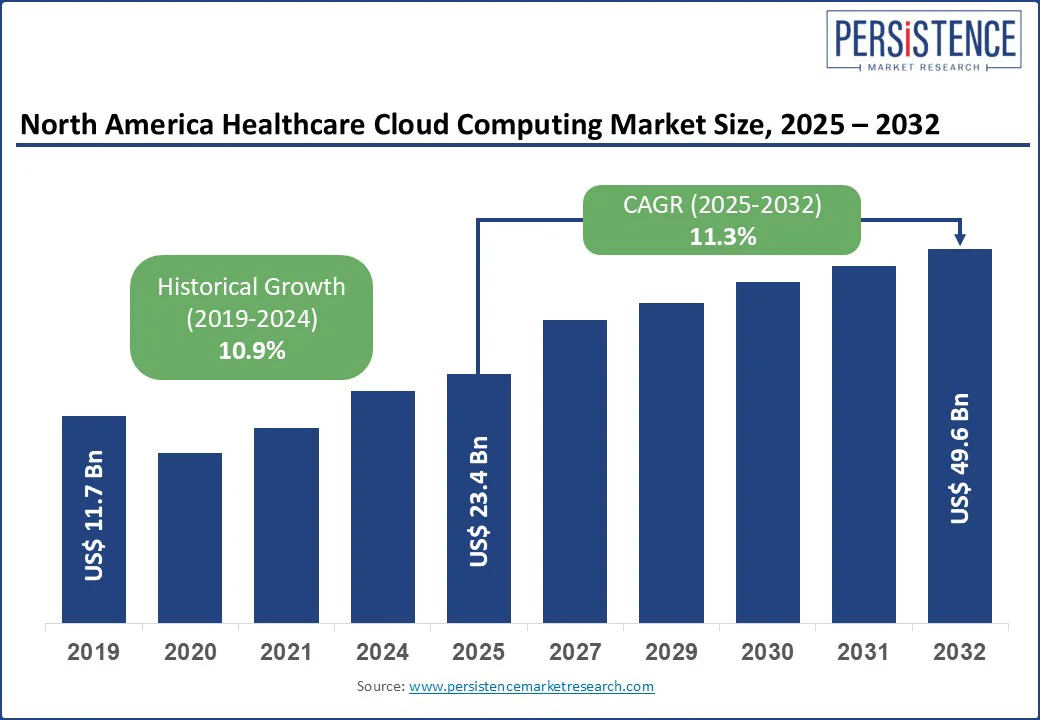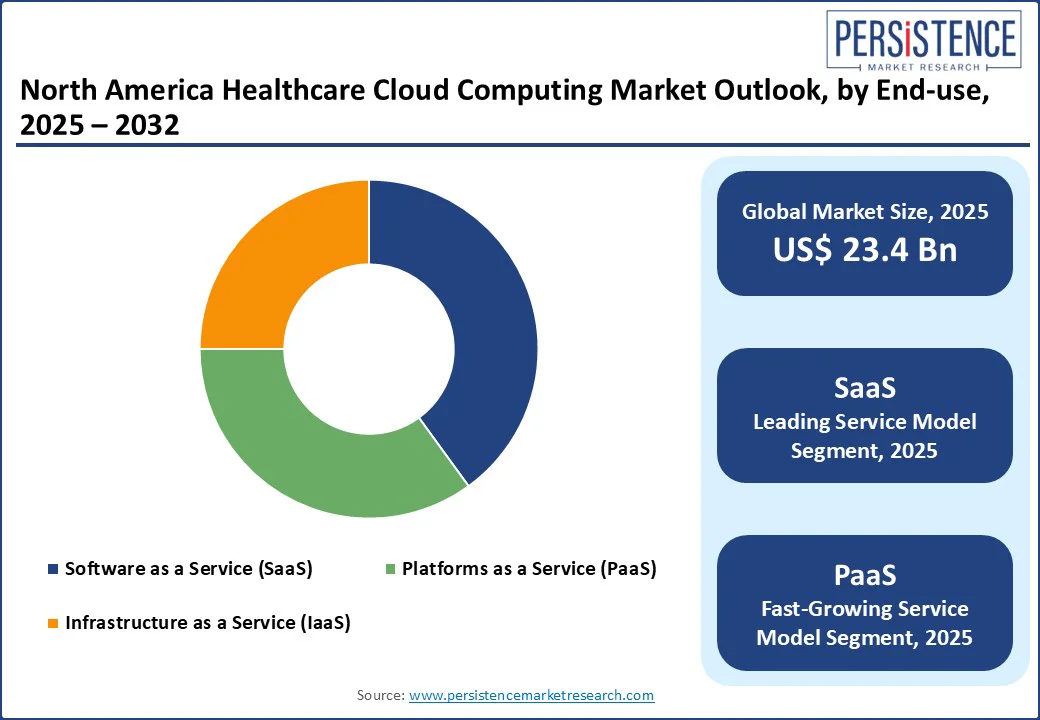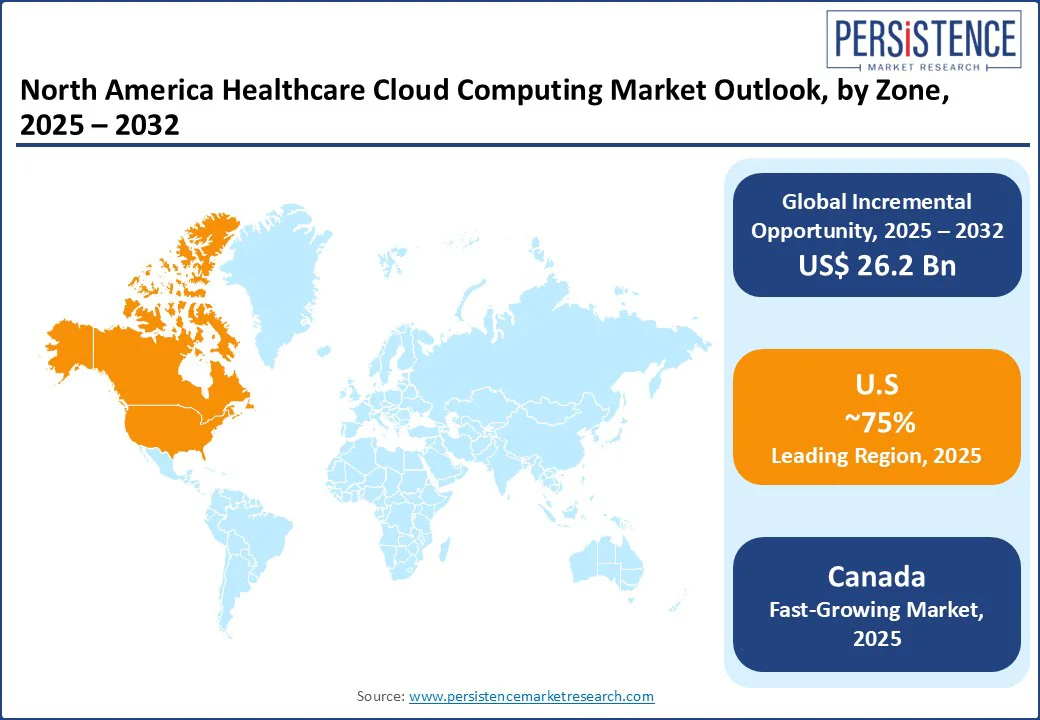ID: PMRREP3319| 196 Pages | 23 Aug 2025 | Format: PDF, Excel, PPT* | Healthcare

The North America healthcare cloud computing market size is likely to be valued at US$23.4 Bn in 2025 and is expected to reach US$49.6 Bn by 2032, growing at a CAGR of 11.3% during the forecast period 2025 - 2032.
The healthcare cloud computing industry in North America is dynamic, driven by the increasing adoption of digital health technologies, regulatory compliance requirements, and the need for scalable and secure data storage solutions. With stringent regulations such as HIPAA, healthcare organizations are turning to private and hybrid cloud models to ensure data privacy and regulatory compliance. Cloud computing offers scalable infrastructure that reduces the need for significant capital investment in IT infrastructure, making it an attractive option for healthcare organizations.
Key Industry Highlights

|
Global Market Attribute |
Key Insights |
|
North America Healthcare Cloud Computing Market Size (2025E) |
US$23.4 Bn |
|
Market Value Forecast (2032F) |
US$49.6 Bn |
|
Projected Growth (CAGR 2025 to 2032) |
11.3% |
|
Historical Market Growth (CAGR 2019 to 2024) |
10.9% |
The North America Healthcare Cloud Computing Market is propelled by several key factors, with a significant focus on the rising adoption of digital healthcare and regulatory compliance, driving demand for health IT cloud, medical cloud solutions, and cloud-based healthcare. The North American healthcare IT market grew by 12% in 2025, increasing demand for cloud-based electronic health records (EHR) systems and healthcare cloud services for telemedicine and remote care.
A 2025 survey noted that 70% of healthcare providers prioritize cloud-based medical IT solutions for interoperability, boosting telehealth cloud platforms and health information management systems by 15%. The rise in telemedicine, with 60% of patients using virtual consultations in 2025, fuels demand for cloud-based patient management and healthcare analytics, with 20% growth in cloud-enabled healthcare technologies.
HIPAA-compliant cloud solutions and secure healthcare data storage, driven by regulations such as the HITECH Act, grew by 18%, ensuring compliance for cloud solutions for healthcare providers. The North American healthcare market, valued at US$4 Tn in 2025, supports cloud computing adoption in hospitals, with 50% of hospitals adopting health data cloud services in 2025.
Data security concerns and high implementation costs pose significant restraints to the North America Healthcare Cloud Computing Market, impacting cloud-based healthcare and health IT cloud adoption. Cybersecurity threats, with 30% of healthcare organizations experiencing data breaches in 2025, limit trust in secure healthcare data storage and HIPAA-compliant cloud solutions.
High implementation costs for cloud-based medical IT solutions, with initial setup costs averaging US$500,000 for mid-sized hospitals, affect cloud computing adoption in hospitals.
Regulatory compliance complexities, with 20% of providers struggling to meet HIPAA standards, increase costs for healthcare cloud services for telemedicine and remote care by 10%, impacting cloud-based patient management scalability. Limited IT infrastructure in smaller healthcare facilities, with 25% of rural providers lacking resources for cloud-enabled healthcare technologies, restricts the adoption of health information management systems in underserved areas.
The rise of healthcare cloud services for telemedicine and remote care, and healthcare analytics in the cloud presents significant opportunities for the North American healthcare cloud computing market. The global telemedicine market is projected to grow at a CAGR of 19.3% through 2032, increasing demand for telehealth cloud platforms and cloud-based electronic health records (EHR) systems. A 2025 report noted that 25% of new healthcare IT solutions incorporate cloud-enabled healthcare technologies, boosting health data cloud services by 20%.
Healthcare analytics in the cloud, with AI-driven insights improving diagnostic accuracy by 15%, enhances cloud-based patient management. Companies such as IBM Corporation are investing US$200 Mn in R&D for cloud-based medical IT solutions and SaaS healthcare solutions, targeting healthcare providers. Emerging technologies, with 2 Mn healthcare professionals adopting AI by 2030, offer opportunities for cloud solutions for healthcare providers and secure healthcare data storage, positioning the health IT cloud as a key growth driver.
Clinical information systems hold approximately 55% of the market share in 2025 due to their use in cloud-based electronic health records (EHR) systems, with 60% adoption in healthcare providers. Cloud-based CIS supports functionalities such as patient monitoring, lab results management, medication tracking, and decision support tools. These systems enable healthcare providers to securely store, access, and manage patient data in real time, improving clinical workflows and patient care outcomes.

Non-Clinical information systems are driven by health information management systems, with 15% growth in 2025. These systems support administrative and operational functions such as billing, scheduling, human resource management, and regulatory reporting. By digitizing non-clinical processes, healthcare organizations can reduce administrative burdens, improve accuracy, and enhance resource allocation.
Private cloud commands a 60% market share in 2025, driven by HIPAA-compliant cloud solutions, with 65% adoption in 2025. Healthcare providers increasingly prefer private cloud solutions for managing electronic health records (EHRs), telemedicine platforms, and other critical applications. Private clouds provide dedicated, secure environments that allow healthcare organizations to store sensitive patient data while maintaining strict regulatory compliance.
Public cloud is fueled by cloud-enabled healthcare technologies, with 18% growth in 2025. Public clouds allow healthcare organizations to access computing resources on demand without investing in on-premises infrastructure, making them suitable for smaller clinics, startups, and digital health innovators. These platforms support interoperability, facilitate remote patient care, and enable the integration of advanced technologies like predictive analytics and machine learning.
SaaS healthcare solutions hold a 50% market share in 2025, driven by telehealth cloud platforms, with 55% adoption in 2025. These solutions allow healthcare providers to access scalable software applications over the internet without the need for on-premises infrastructure. Telehealth platforms have gained momentum as they enable remote patient consultations, virtual care management, and secure communication between patients and providers.
PaaS are fueled by healthcare analytics in cloud, with 20% growth in 2025. PaaS provides a framework for developers and healthcare organizations to build, deploy, and manage custom applications without managing the underlying infrastructure. Healthcare analytics platforms enable organizations to collect, process, and analyse large volumes of patient and operational data to optimize outcomes, detect patterns, and improve resource allocation.
Healthcare providers hold a 70% market share in 2025, driven by cloud solutions for healthcare providers, with 75% adoption in 2025. These cloud platforms enable providers to securely store and manage patient data, streamline administrative workflows, and improve care coordination. Features such as electronic health records (EHR) management, telemedicine support, and predictive analytics are becoming integral to modern healthcare operations.
Healthcare payers are fueled by health information management systems, with 15% growth in 2025. These systems enable payers to process claims more accurately, monitor patient health trends, and manage large volumes of health data effectively. HIMS allows payers to assess risk profiles, detect fraud, and optimize reimbursement processes.

The North America healthcare cloud computing market is highly competitive, with health IT companies competing on innovation, security, and scalability. CareCloud Corporation and Microsoft Corporation dominate in SaaS healthcare solutions, while IBM Corporation leads in healthcare analytics in cloud. Cloud-based medical IT solutions, HIPAA-compliant cloud solutions, and cloud solutions for healthcare providers add a competitive layer. Strategic partnerships and R&D investments in healthcare cloud services for telemedicine and remote care are key differentiators.
North America healthcare cloud computing market is projected to reach US$ 23.4 Bn in 2025, driven by health IT cloud and medical cloud solutions.
Digital healthcare adoption, cloud-based electronic health records (EHR) systems, and HIPAA-compliant cloud solutions are key drivers.
North America healthcare cloud computing market grows at a CAGR of 11.3%, reaching US$ 49.6 Bn by 2032.
Opportunities include healthcare cloud services for telemedicine and remote care, healthcare analytics in cloud, and telehealth cloud platforms.
Key players include CareCloud Corporation, IBM Corporation, Microsoft Corporation, Oracle Corporation, and Cisco Systems.
|
Report Attribute |
Details |
|
Historical Data/Actuals |
2019 - 2024 |
|
Forecast Period |
2025 - 2032 |
|
Market Analysis Units |
Value: US$ Bn, Volume: As Applicable |
|
Geographical Coverage |
North America |
|
Segmental Coverage |
|
|
Competitive Analysis |
|
|
Report Highlights |
|
|
Customization and Pricing |
Available upon request |
By Application
By Deployment Model
By Service Model
By End-use
Delivery Timelines
For more information on this report and its delivery timelines please get in touch with our sales team.
About Author